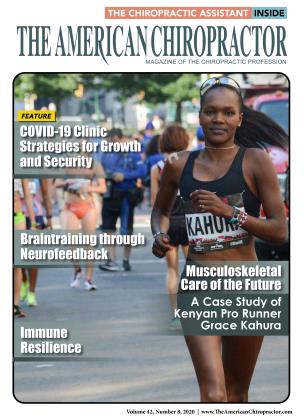Better Brain Function -Naturally!
FEATURE
By
Ed Carlton
DC, BCN
What if you could help your patients better control their thoughts and feelings? What if you could provide a service that can naturally train their brains to be in better command of their emotions and mood in any situation?
Even better, what if you could naturally eliminate the symptoms associated with a host of brain-based conditions—from ADHD1 to PTSD2—leading to life-changing improvements in your patient's quality of life?
Maybe they want to improve their cognitive performance.3 Be more effective and creative at work, or be better at their favorite sport. By improving brain function, a clinician can help patients achieve their true potential while anxiety and loss of concentration become a thing of the past.
As it turns out, the ability to do all of these things already exists through neurofeedback training.
Neurofeedback is a specialized type of biofeedback that helps train the brain to regulate basic brainwave generation, leading to more efficient, healthier mental function. First used in 1972 for the treatment of epilepsy,4 this technology represents a drug-free modality for improving many brain-based illnesses.
First, a brain map is done.
As we know, the brain is a highly complex organ made up of billions of neurons that send and receive messages to and from all parts of our body. This electrical flow in the brain can be measured and mapped using an electroencephalogram (EEG). Typically, the raw data is analyzed, looking for anomalies that could reflect damage from a stroke or a physical anomaly, such as an underlying tumor. However, for the purpose of neurofeedback training, a functional analysis is performed. The EEG data is compared to other EEG results for individuals of the same age. This is known as a “brain map.”
Think of it as a specialized mental “fitness test.”
The brain map provides the clinician with the data to create a training protocol. Modern equipment performs this function automatically, providing treatment recommendations for the clinician to use based on the analysis. Chiropractors, with their knowledge of neuroanatomy and physiology, are well equipped to utilize these recommendations directly.
Like chiropractic, neurofeedback training uses the body's natural healing process to help it develop new neural pathways. Known as “operant conditioning,” it originates from cognitive behavioral therapy. From a clinical perspective, neurofeedback training can provide an alternative, holistic approach for patients dealing with brain-based illnesses.
These sensors provide the data used for the neural feedback loop.
The training is like “physical therapy” for the brain.
Training sessions are easily administered and an enjoyable patient experience. During a brain training session, the patient will sit quietly in a comfortable chair and watch their choice of a movie or video. Sensors to measure brainwave output are lightly placed on the scalp using conductive gel. These sensors provide the data used for the neural feedback loop. A normal training session lasts 30 minutes. The neural feedback is continuous and responds within milliseconds when the brainwave activity goes above or below the desired thresholds. When this happens, the movie dims, due to changes in the audio and visual inputs, providing feedback based on the patient’s real-time brainwave activity.
Neurofeedback creates change in the four basic brainwave frequencies.
There are four primary brainwave frequencies, and they are each present at all times—delta, theta, alpha, and beta, from slowest to fastest in frequency. The amount of activity in each frequency band varies depending on activity level, patient age, and the conditions patients may be suffering from.
For example, anxiety can be associated with an excess of high beta waves (15 to 30 cycles/sec).5 If this were the case with your patient, one of the training goals would be to decrease this excess.
So, while training, when the patient starts experiencing anxiety, the audio and visual inputs vary, causing the brain to slow down and returning the patient to a calmer, healthier mental state.
Just like physical exercise, the brain develops new “muscles.”
A normal training regimen consists of a series of 30-minute sessions. The number of sessions varies and is determined by the patient’s history, and the results of the brain map. Over time, the brain develops new neural pathways in response to the repeated feedback signals experienced in a training session.
Remember when you learned to ride a bike? You learned that if you got out of balance, typically, you would fall. Over time, your brain and body learned how to stay in balance under many different conditions. Years later, the muscles are different, but the neural pathways built during those riding sessions remain intact, allowing you to ride a bike years after last riding one.
Long-term relief.
That's basically how neurofeedback training works. It uses audio and visual feedback cues to teach the brain to stay in balance, and just like learning to ride a bike, the neural changes are long lasting. This can allow a clinician to provide patients with true, longterm relief from the brain-based symptoms caused by imbalanced patterns of brainwave generation.6
References:
1. * ADD/ADHD: https://journals.sagepub.com doi 10.1177/155005940904000311
2. PTSD:https://journals.plos. org plosone article ? id= 10.1371 /journal.pone. 0166752
3. Executive Function, Behavior: https://journals. sagepub.com/doi/10.1177/1087054715577135
4. Epilepsy: https: //www. ncbi. nlm. nib. gov/pmc/ articles /PMC4126150/
5. Excess Beta waves: Priyanka A. Abhang, ... Suresh C. Mehrotra, in Introduction to EEGand Speech-Based Emotion Recognition, 2016
6. Long Term relief: https://www. amazing-
brains. com/wpcontent/uploads/2014/01/
Neurofeedback-and-neuromodulation-techniques-and-applications-Book.pdf
7. The Answer pge 41-42: https://carltonneurofeedbackcenter.com/neurofeedback-e-book/
Dr. Ed Carlton is board certified in neurofeedback training, and has been a chiropractor for 30 years. Diagnosedwith bipolar disorder in mid-life, he spent years searching for a natural solution, to help him get off medications. His goal is to help other doctors successfully enter and thrive in this business, helping patients with brain-based disorders naturally. For more information contact him at edcarltonl [email protected]
 View Full Issue
View Full Issue









